The Sun and Moon appear to dance together due to their gravitational relationship and unique size-distance ratio—the Sun is about 400 times larger than the Moon but also 400 times farther away. This cosmic coincidence creates spectacular solar eclipses when they align perfectly. Their orbital mechanics drive the Moon’s phases, tides, and eclipse cycles that have fascinated cultures throughout history. You’ll discover how this celestial partnership has shaped human experience across millennia.
Why Do The Sun And Moon Dance Together?
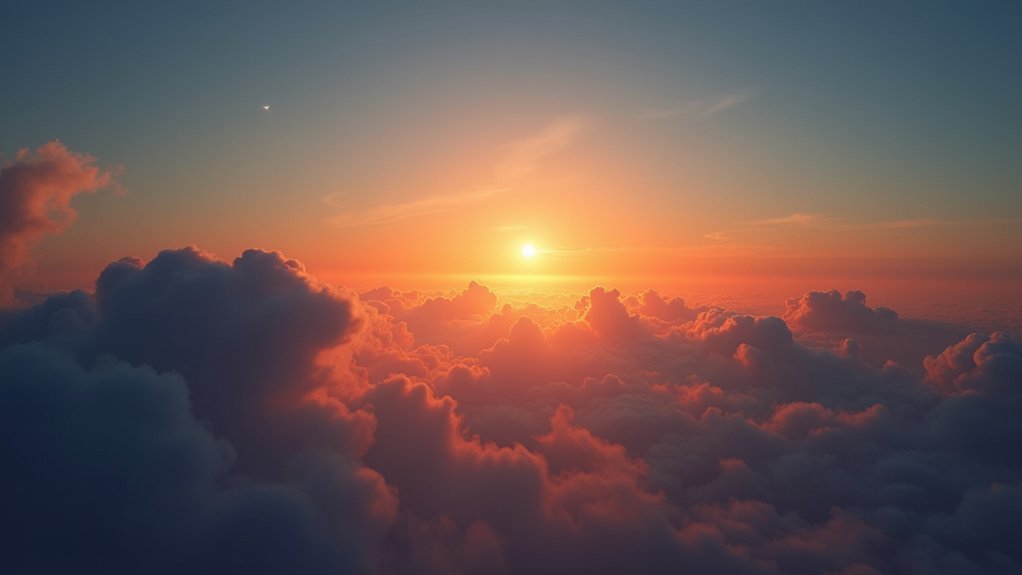
How often do you pause to witness the cosmic ballet unfolding above? The Sun and Moon engage in a gravitational tango that shapes our experience of time and space.
When you observe the Moon’s phases changing over 29.5 days, you’re watching this dance in action. The Moon glides approximately 12-13 degrees eastward daily, constantly repositioning itself relative to the Sun. This movement creates the waxing and waning cycle we depend on for calendars and cultural traditions.
The lunar waltz through our skies writes nature’s calendar in light and shadow, marking humanity’s rhythm since time began.
The Moon’s synchronous rotation guarantees we always see the same face, while its orbit occasionally aligns perfectly with Earth and the Sun to create eclipses—dramatic moments in this celestial choreography.
These alignments aren’t merely beautiful; they drive our ocean tides and have influenced human civilization throughout history.
The Celestial Partners: Understanding Sun and Moon Basics
To appreciate the celestial dance above us, we must first know the dancers themselves. The Sun and the Moon, while vastly different in size, work in harmony to influence Earth’s gravitational dynamics and create the rhythms that govern our planet.
Your Moon completes its orbit around Earth approximately every 27 days, displaying different phases as it travels. Due to synchronous rotation, you’ll always see the same lunar face.
The Moon doesn’t generate light but reflects the Sun’s brilliance—appearing differently depending on whether you’re viewing from the Northern or Southern Hemisphere.
When these celestial partners align with Earth, they create eclipses—either solar, when the Moon blocks the Sun, or lunar, when Earth casts its shadow upon the Moon.
When Shadows Align: The Mechanics of Solar Eclipses
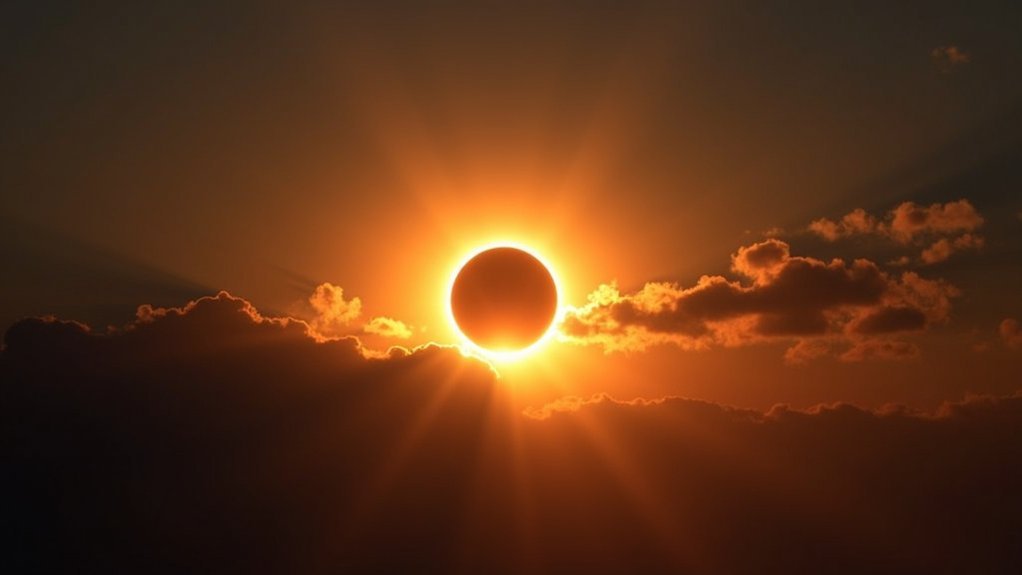
During the most dramatic act of the Sun-Moon dance, our daytime sky transforms into twilight as the Moon perfectly aligns between Earth and the Sun. This rare alignment occurs during the new moon phase when our celestial neighbor positions itself directly in our line of sight to the Sun.
When Moon meets Sun in perfect alignment, day surrenders to twilight in nature’s celestial ballet.
Within our solar system, this cosmic choreography creates one of nature’s most spectacular phenomena—a solar eclipse. You’ll only witness this event if you’re standing in the path of the Moon’s shadow as it traces a narrow band across Earth’s surface.
The experience varies depending on:
- Your location within the shadow path
- The specific geometry of the Earth-Moon-Sun alignment
- The duration of totality, which ranges from seconds to over 7 minutes
The Perfect Cosmic Coincidence: Size and Distance Ratios
You’re witnessing one of the universe’s most remarkable coincidences when you observe the Sun and Moon in our sky—they appear almost identical in size despite their vast difference in actual dimensions.
This perfect alignment occurs because the Sun is approximately 400 times larger than the Moon but also roughly 400 times farther away from Earth, creating the precise conditions needed for total solar eclipses.
During these rare events, the Moon’s shadow can completely block the Sun’s brilliant disc, allowing us to glimpse the otherwise invisible solar corona and experience darkness in daylight.
Cosmic Mathematical Marvel
Perhaps the most extraordinary coincidence in our solar system lies in the perfect match between the Sun and Moon’s apparent sizes in Earth’s sky.
This cosmic ballet isn’t just beautiful—it’s a mathematical marvel that showcases the elegance of celestial mechanics.
The Moon’s orbit around Earth creates this remarkable phenomenon through three key mathematical relationships:
- The Sun is approximately 400 times larger than the Moon.
- The Sun is also about 400 times farther away from Earth than the Moon.
- This 400:400 ratio creates the precise alignment necessary for total solar eclipses.
You’re witnessing a cosmic coincidence that allows the Moon to perfectly cover the Sun during eclipses, creating the corona’s spectacular display.
This mathematical harmony transforms what could have been ordinary occultations into breathtaking astronomical events unique in our solar system.
Shadow Show Mechanics
The cosmic mathematics we just explored reveals itself through a spectacular shadow play in our skies.
When you witness an eclipse, you’re seeing a perfect celestial alignment that’s remarkably precise. The Moon’s orbit around Earth places it at just the right distance—about 384,400 kilometers away—to appear the same size as the Sun when viewed from Earth.
This cosmic coincidence occurs because while the Sun is approximately 400 times larger than the Moon (1.4 million kilometers versus 3,474 kilometers in diameter), it’s also about 400 times farther away (149.6 million kilometers).
This precise ratio allows the Moon to completely cover the Sun during a total solar eclipse, despite their vast size difference.
The 5-degree tilt of the Moon’s orbital plane explains why this shadow show remains a rare spectacle.
Types of Solar Eclipses: Total, Partial, and Annular
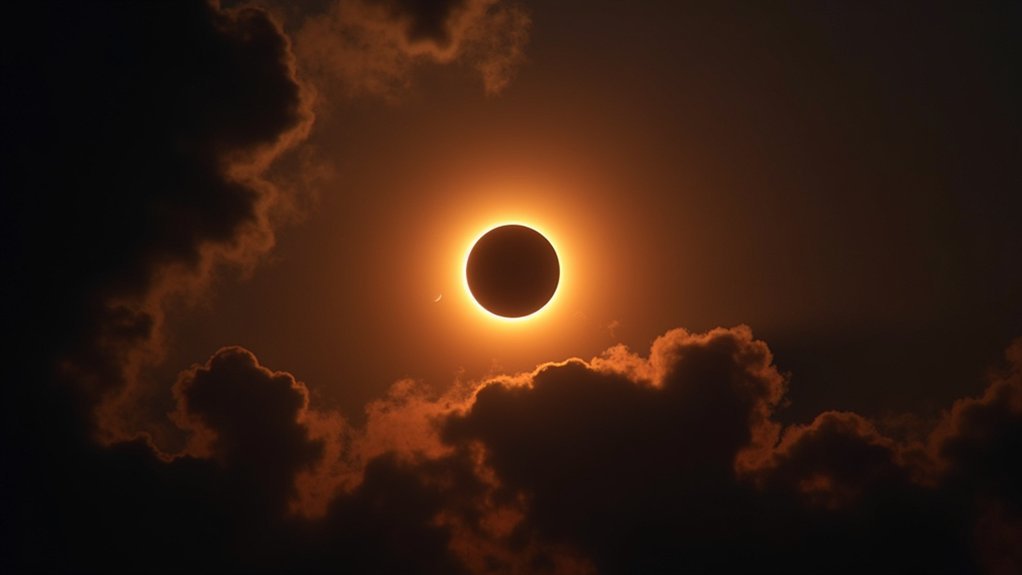
During a total solar eclipse, you’ll witness the breathtaking diamond ring effect when the Sun’s last visible light creates a brilliant flash resembling a cosmic diamond set in a ring.
As the Moon fully covers the Sun, you’re treated to the Sun’s magnificent corona—a pearly white halo of plasma normally invisible to the naked eye.
Just before and after totality, you might spot shadow bands, those elusive ripples of light and dark that shimmer across surfaces like waves of water dancing across the landscape.
Diamond Ring Effect
Among the most breathtaking moments in astronomy, the Diamond Ring Effect dazzles observers when the last rays of sunlight pierce through the Moon’s rugged landscape during a total solar eclipse.
This fleeting phenomenon appears twice during totality—just before and immediately after—lasting mere seconds as the Sun’s corona becomes visible.
You’ll recognize this spectacular moment when:
- The Moon perfectly aligns with the Sun, creating a brief burst of light resembling a diamond on a ring
- The Sun’s corona forms the “ring” while the final beam of sunlight creates the “diamond”
- The Moon’s distance from Earth determines the effect’s visibility—only during total eclipses, not partial or annular ones
For eclipse chasers, this magical effect marks both the beginning and end of totality’s darkness.
Corona’s Magnificent Display
When our Moon perfectly aligns with the Sun, you’ll witness one of nature’s most awe-inspiring spectacles: the Sun’s hidden corona disclosed in its full splendor. This dazzling phenomenon occurs only during a total solar eclipse, when the Moon completely blocks the Sun’s bright disk.
Unlike partial eclipses that create a crescent Sun or annular eclipses with their “ring of fire,” only totality reveals the corona’s magnificent display. The Moon’s phases play an essential role here – solar eclipses can only happen during a new moon when Earth, Moon, and Sun align precisely.
For several precious minutes, you’ll see the pearly white corona extending outward from the Sun’s darkened face. This rare glimpse of the Sun’s outer atmosphere remains invisible during normal daylight, making total eclipses truly extraordinary celestial events.
Shadow Bands Phenomenon
Fleeting waves of light and shadow dance across the ground moments before and after totality, creating a mesmerizing display known as shadow bands.
During a total solar eclipse, these elusive patterns appear as the last rays of sunlight filter through Earth’s atmosphere, which acts like a natural prism.
You’ll witness shadow bands with varying intensity depending on the eclipse type:
- Total solar eclipse – Most dramatic display, with pronounced bands visible just before and after totality when the Moon completely covers the Sun.
- Partial eclipse – Less defined bands as the Moon only partially blocks the Sun.
- Annular eclipse – Minimal to no shadow bands since the “ring of fire” prevents complete darkness.
To catch this rare phenomenon, position yourself in the path of totality and prepare to be amazed by these atmospheric ripples.
Eclipse Safety: Protecting Your Eyes During the Dance
How can you safely witness the celestial dance between sun and moon without risking your vision? The sun’s rays can cause solar retinopathy—permanent vision damage—even during an eclipse. You must use proper protection.
| Safe Viewing Method | Protection Level | Usage Notes |
|---|---|---|
| ISO 12312-2 eclipse glasses | Complete | Inspect for damage first |
| Pinhole projector | Indirect | Projects image onto surface |
| Regular sunglasses | None | Never use for eclipse viewing |
Predicting the Dance: Eclipse Seasons and Saros Cycles
The cosmic choreography between sun and moon follows remarkably predictable patterns that ancient civilizations discovered long before modern astronomy.
Twice yearly, eclipse seasons occur when the celestial bodies align perfectly enough for eclipses to happen during New and Full Moon phases.
The Saros cycle—an 18-year, 11-day, 8-hour period—serves as nature’s eclipse calculator, allowing you to predict when these spectacles will recur.
Every 18 years, 11 days, and 8 hours, the Saros cycle resets nature’s cosmic clock, unveiling eclipses with mathematical precision.
This happens because the Moon must be near one of its nodes where its orbit intersects Earth’s plane.
These predictable cycles offer you:
- Foreknowledge of when and where future eclipses will occur
- Understanding of the 70-80 eclipse pattern in each Saros series
- Appreciation for the mathematical precision of our celestial neighborhood
Cultural Interpretations of Solar Eclipses Throughout History
Throughout human history, solar eclipses have inspired awe, fear, and profound mythological explanations as cultures worldwide struggled to comprehend these dramatic celestial events.
In ancient China, people believed a dragon swallowed the sun during eclipses, representing a cosmic struggle between light and darkness. Northern Scandinavian tribes attributed these phenomena to wolves chasing away the sun, while other cultures saw them as divine messages indicating the sun’s anger over human transgressions.
You’ll find that many ancient societies viewed eclipses romantically, interpreting them as celestial unions between the sun and moon—opposing forces meeting in the heavens.
These interpretations weren’t merely stories; they reflected humanity’s attempt to understand significant astronomical events and incorporate them into spiritual frameworks that explained transformation and cosmic order in their societies.
Witnessing the Spectacle: What to Expect During a Solar Eclipse
Witnessing a solar eclipse firsthand transforms our understanding of celestial mechanics from abstract concept to breathtaking reality. This rare alignment occurs only during a new Moon when Earth, Moon, and Sun form a perfect line.
As the Moon gradually covers the Sun, you’ll experience three remarkable phases:
- Dimming daylight – The world around you slowly darkens, temperatures drop noticeably, and shadows sharpen into strange crescent patterns.
- Animal reactions – Birds may stop singing and insects might begin their evening chorus, confused by the sudden twilight.
- The corona reveals itself – If you’re within the narrow path of totality, you’ll witness the Sun’s outer atmosphere glowing like a silver halo around the Moon’s silhouette.
Remember to use proper eye protection throughout the eclipse except during totality.
Frequently Asked Questions
What Is the Spiritual Meaning of the Sun and the Moon Together?
You’ll find the sun and moon together represent your inner balance between conscious self (sun) and emotional depths (moon). They remind you that embracing both your light and shadow creates spiritual wholeness.
What Is the Purpose of the Sun Dance?
The Sun Dance serves as your spiritual renewal ceremony. You’ll participate in fasting and dancing to honor the Creator, seek blessings for your community, strengthen tribal bonds, and reconnect with ancestral traditions and cosmic energies.
Why Are the Sun and Moon Out Together?
You can see the Sun and Moon together when the Moon’s orbit positions it at the right angle to reflect sunlight during daylight hours, typically during its first or last quarter phases.
What Does It Mean When You Have a Sun and Moon Couple?
A Sun and Moon couple means you’re in a relationship where one partner’s core identity (Sun) aligns with the other’s emotional needs (Moon). You’ll experience natural understanding and complementary energies that create deep emotional harmony.
In Summary
You’ve now seen why the sun and moon appear to dance together across our skies. Their celestial ballet, perfectly synchronized through cosmic coincidence, creates one of nature’s most awe-inspiring displays. Whether you’re planning to witness your first eclipse or your fiftieth, remember to protect your eyes while watching this remarkable partnership. The sun and moon’s dance continues, predictable yet magical, connecting us to countless generations of stargazers.
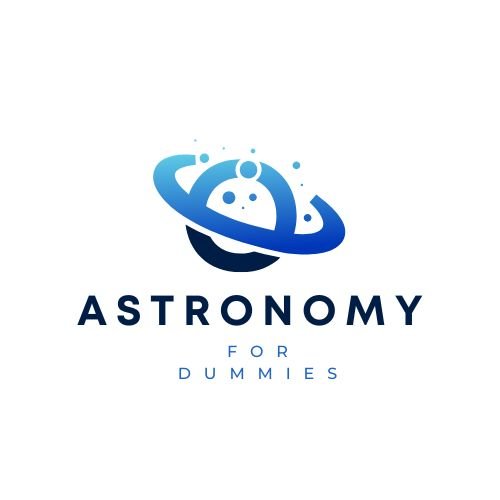
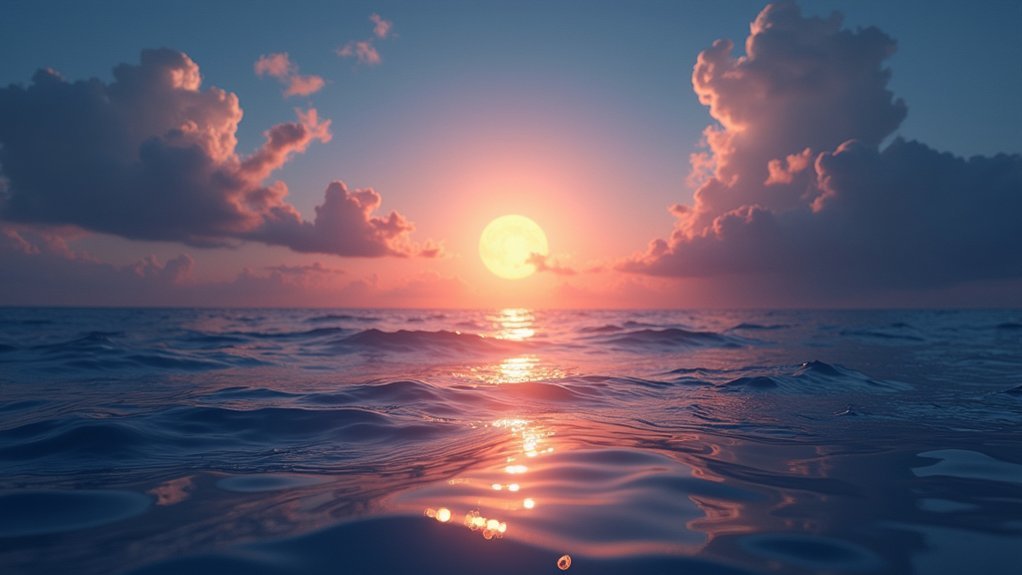


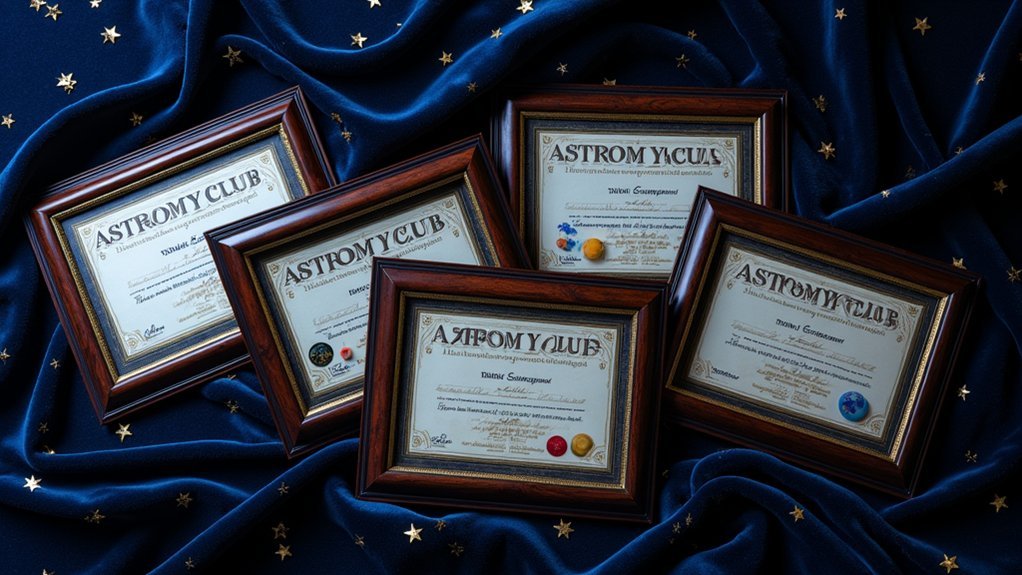
Leave a Reply